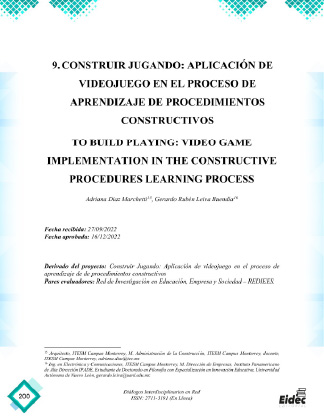IX. CONSTRUIR JUGANDO: APLICACIÓN DE VIDEOJUEGO EN EL PROCESO DE APRENDIZAJE DE PROCEDIMIENTOS CONSTRUCTIVOS
##plugins.themes.bootstrap3.article.main##
Resumen
En el entorno de la pandemia de Covid 19, los alumnos de las clases de
procedimientos constructivos de una universidad privada ubicada en el noreste de México se
encontraron con la restricción de no poder asistir a visitas de obra y depender absolutamente
del mundo digital para el aprendizaje. Bajo esta perspectiva, los profesores nos encontramos
con el reto de crear entornos atractivos e interesantes para que los alumnos pudiesen aprender
de forma más activa, logrando mantener el interés del alumno por adquirir conocimientos por
medio de una plataforma interactiva. Los objetivos de este trabajo son mostrar el proceso por
el cual los alumnos de 5º semestre de arquitectura pudieron usar una plataforma tipo juego
para aprender y desarrollar competencias que se vieron afectadas por el encierro forzoso
durante la pandemia. La metodología empleada consistió en aplicar herramientas basadas en
juegos para simular situaciones reales de trabajo, conectando los contenidos conceptuales
con los procedimentales y actitudinales, de forma que el aprendizaje se logre de forma
integral y no sólo aisladamente como se había ido desarrollando durante el encierro. Los
autores buscan validar que los juegos interactivos sean una herramienta eficaz para el
desarrollo de habilidades de liderazgo, solución de problemas y colaboración entre los
alumnos. Los resultados obtenidos fueron muy satisfactorios, ya que los alumnos expresaron
un gran interés por la actividad y la aplicación de conceptos que hasta el momento se habían
visto de forma teórica en un entorno que a ellos les parecía atractivo y familiar. El hecho de
usar un entorno lúdico tecnológico permitió incrementar el interés y la motivación de los
estudiantes en el aprendizaje logrando un conocimiento más integrado y completo.
Download Statistics
##plugins.themes.bootstrap3.article.details##
Aprendizaje, Construcción, Gamificación, Juegos.
Primaria. Universidad de Valladolid. Recuperado el 17/02/2017 de:
https://bit.ly/3DsQZK7
Deterding, S., Dixon, D., Khaled, R., y Nacke, L. (2011). From game design elements to
gamefulness: defining gamification. International Academic MindTrek Conference:
Envisioning Future Media Environments (pp. 9-15). ACM
Erenli, K. (2012). The impact of gamification: A recommendation of scenarios for education.
In Interactive Collaborative Learning (ICL), 2012 15th International Conference on
(pp. 1-8). IEEE.
Espeso, P (2022). ¿Qué es Minecraft, en qué consiste y por qué todo el mundo habla de él?,
Educación 3.0. Recuperado de https://bit.ly/3S6thri
Espí, M. J. y Azurmendi, M. J. (1996). Motivación, actitudes y aprendizaje del español
como lengua extranjera. RESLA, 11 (1996), 63-76. Recuperado de:
https://bit.ly/3xuTojX
García, F. Y Doménech, F. (1997). Motivación, aprendizaje y rendimiento
escolar. Revista electrónica de motivación y emoción. Recuperado el 24/03/2017 de:
https://bit.ly/3eZzrek
Hamari, J., Koivisto, J., y Sarsa, H. (2014,). Does gamification work? --a literature review
of empirical studies on gamification. In System Sciences (HICSS), 2014 47th Hawaii
International Conference (pp. 3025-3034). IEEE.
King, D., Greaves, F., Exeter, C., y DARZI, A. (2013). ‘Gamification’: Influencing health
behaviours with games. Journal of the Royal Society of Medicine, 106(3), 76-78.
Manrique, C. R. C., & Puente, R. M. T. (1999). El constructivismo y sus implicancias en
educación. Educación, 8(16), 217-244.
Mohammad, A. S. (2014). Gameducation: Using Gamification Techniques to Engage
Learners





